Abstract
Free space optical communication (FSO) is widely deployed to transmit high data rates for rapid communication traffic increase. Asymmetrically clipped optical orthogonal frequency division multiplexing (ACO-OFDM) modulation is a very efficient FSO communication technique in terms of transmitted optical power. However, its performance is limited by atmospheric turbulence. When the channel includes strong turbulence or is non-deterministic, the bit error rate (BER) increases. To reach optimal performance, the ACO-OFDM decoder needs to know accurate channel state information (CSI). We propose novel detection using different deep learning (DL) algorithms. Our DL models are compared with minimum mean square error (MMSE) detection methods in different turbulent channels and improve performance especially for non-stationary and non-deterministic channels. Our models yield performance very close to that of the MMSE estimator when the channel is characterized by weak or strong turbulence and is stationary. However, when the channel is non-stationary and variable, our DL model succeeds in improving the performance of the system and decreasing the signal to noise ratio (SNR) by more than 8 dB compared to that of the MMSE estimator, and it succeeds in recovering the received data without needing to know accurate CSI. Our DL decoders also show notable speed and energy efficiency improvement.
1. Introduction
Free space optical (FSO) communication has been widely used due to its capability to transmit with high data rates [1,2], thus supporting the rapid increase in the amount of traffic passing through communication networks [3,4]. The use of FSO communication has many advantages compared to optical fiber and radio frequency (RF) networks. FSO enables transmission with high data rates as in optical fibers, but in FSO communication, the data is transmitted by light in free space through the air and not by cable. This increases the flexibility of the networks compared to optical fiber networks, and it leads to dynamic wireless network capabilities, as well as decreasing the energy consumption of the communication networks, which is a very important consideration in our world. In addition to these, the installation of new FSO networks is easier and cheaper than the installation of new optical fiber networks. Furthermore, FSO communication is faster than RF; in FSO communication, there is no need for a spectrum license as in RF; and in FSO, there no need to use complicated security methods as in RF, because the data is transmitted along line of sight (LOS) paths and the wavelength is very small, which makes it difficult to eavesdrop. Therefore, FSO is more secure than RF and more resistant to RF interference [5,6].
However, one of the most severe limitations on the performance of FSO in real environments is atmospheric turbulence, which stems from random refractions that lead to random fluctuations in the amplitude and phase of the received signal. Turbulence limits the use of FSO not only in the atmosphere, but also in data center environments where turbulence is derived from the local heating. In addition, recovering transmitted data at the receiver requires previous knowledge of the parameters of the encoder and decoder and accurate knowledge of the channel state information (CSI) of the turbulence in order to overcome noise [2,5].
Recently, the use of optical orthogonal frequency division multiplexing (OOFDM) has been widely considered for FSO communication, because it is robust against inter symbol interference (ISI) and exhibits high spectral efficiency. In OOFDM, M-Quadrature Amplitude Modulation (M-QAM) is used for high bandwidth efficiency. However, OOFDM works with intensity modulation and direct detection (IM/DD), so only modulated signal intensity can be transmitted [6]. Therefore, the transmitted signal can only be bipolar and real, while in regular OFDM, the transmitted signals can be nonbipolar and complex. Many methods have been suggested for the implementation of OOFDM in FSO communication [7,8,9,10,11,12]. One of these methods that can convert the transmitted signals to be bipolar and real without any loss of the transmission information is asymmetrically clipped optical orthogonal frequency division multiplexing (ACO-OFDM) modulation [8]. This is a very efficient technique for FSO in terms of transmitted optical power, more so than the methods that use data center (DC) biasing to convert the transmitted data to unipolar. Due to these advantages, we choose to investigate ACO-OFDM in this paper.
In ACO-OFDM, the transmitted signals are made real by transmitting only the odd subcarriers, while the even subcarriers are set to zero [5,6,13]. However, in FSO communication, there is interference that derives from ambient light sources and turbulence. Therefore, estimating the CSI is important in order to successfully recover the data. We will suggest different techniques for estimating the CSI. The authors in [10] suggest using a least square (LS)-based channel estimator to achieve accurate results in ACO-OFDM FSO systems, while the authors in [11,12] suggest using the minimum mean square error (MMSE) and linear MMSE (LMMSE). In the LS estimation method, optimal channel state estimation can be achieved when the channel is optimal, without noise and without interference. The accuracy with MMSE is better and higher than with LS but is limited due to the noise. However, in real environments, such as communication inside data centers, underwater communication, and molecular communication, there is turbulence, which can affect detection of the recovered signals. In the regular estimation methods mentioned above, it is difficult to accurately extract CSI, because in some cases, the turbulence is strong, or the channel is variable and non-deterministic, which makes estimation difficult. Consequently, in these methods, it is necessary to transmit with more power or use other mitigation methods in order to achieve good performance. As a result, there is a need to build ACO-OFDM systems that can enable us to realize a complete communication system without having to know the parameters of the channel model in order to maximize the performance of the communication system. We demonstrate that the use of deep learning (DL) algorithms for recovering the transmitted data in ACO-OFDM modulated signals can be an effective solution for FSO through turbulent channels, thereby improving the performance of the communication system.
Deep neural networks (DNNs) is one of the important algorithms that is widely used in DL. DNNs have tools that enable learning complicated models, which helps to optimize the performance of the entire system by learning relationships between input and output variables through training processes. In recent years, researchers have used DL models in different areas, such as image and speech recognition [14,15], and wireless communication systems for encoding, decoding, channel estimation, and signal identification [16,17,18]. The use of DL in wireless communication systems can help improve system performance without the need to know the parameters of the channel or the encoder. In regular communication systems, the system is composed of several blocks, and one tries to maximize the performance of each block separately. However, the use of DL in wireless communication systems allows us to view the transmitter or the receiver as a single unit. The performance of the entire block is maximized by minimizing the bit error rate (BER), rather than trying to maximize each block separately as in regular encoders and decoders. This can improve the performance of the entire wireless communication system [18]. In recent years, researchers have used DL in different optical communication systems. In [19], researchers succeeded in using DL for reducing computational complexity in optical communication systems. In [20], the authors use it in detection through atmospheric turbulence for orbital angular momentum in FSO communication. The authors in [21] successfully used DL to mitigate fiber-induced nonlinearity. In [22], DL was used as a solution for the imperfect CSI problem in FSO communication systems. Recently, in [23], we used DL for improving the performance of on–off keying (OOK) modulation over different FSO turbulence channels.
In this study, we show a new detection method of modulated ACO-OFDM signals using different models of DL. The noisy modulated transmitted data are recovered without the need to know any parameters about either the channel or the encoder. We examined the performance of the DL-assisted ACO-OFDM by generating random data bits modulated by ACO-OFDM. The data were transmitted via a different turbulent channel with additive white Gaussian noise (AWGN). The receiver receives the modulated data with noise and needs to recover the original data bits from the received data using different algorithms of DL, without the need to know anything about the modulation parameters or the parameters of the channel. The developed DL models were compared with one another and also with the regular ACO-OFDM decoder that uses the MMSE estimator, in terms of BER and computational and memory complexity that can affect the power consumption of the system. An improvement in the performance of ACO-OFDM, quantified by a decrease in the BER in all the DL models, was observed, especially over channels with strong or variable turbulence. Our proposed DL models obtain performance that is slightly better than that of an MMSE estimator, especially when the channel is stationary with weak or strong turbulence. In addition, when the turbulent channel is non-stationary and variable, we find a significant improvement in system performance, and the BER is decreased by more than 8 dB compared with regular ACO-OFDM using the MMSE estimator. In addition, our DL decoders run faster than the regular ACO-OFDM decoder, which leads to a significant reduction in the energy consumption of the FSO system.
The rest of this paper is built in the following manner. Section 2 describes the FSO turbulent channel characteristics and the ACO-OFDM encoder–decoder system. The DL decoders we developed are presented in Section 3. In Section 4, we summarize the results of our simulations. Section 5 presents the conclusions of the study and future perspectives of the work.
2. ACO-OFDM System Model
2.1. Turbulent Channel Characteristics
In FSO communication, the transmitted signals propagate in free space through atmospheric turbulence. The turbulent channel includes changes in the refractive index structure parameter caused by inhomogeneities in the temperature and pressure of the atmosphere [1,2]. At the receiver, the atmospheric turbulence causes random fluctuations in the amplitude and the phase of the received signal, which leads to signal scintillation and affects the performance of the FSO system model. The fluctuations and the changes in the temperature through the turbulent channel can be described by the parameter , which is the refractive index structure parameter. Different statistical models have been proposed over the years to model the atmospheric turbulent channel, depending on the strength of the turbulence, which ranges from weak to strong [24]. The Rytov variance is the parameter that determines the strength of the turbulence. It depends on the value of and can be calculated by
where L is the distance between the transmitter and the receiver, is the wave number, and λ is the wavelength. In the case of weak turbulence , the intensity of the received signal that passes through weak turbulence is lognormally distributed, and the probability density function (PDF) can be described by
where I is the received signal intensity at the receiver, is the Rytov variance and refers to the variance of the log amplitude of the received signal, is the mean of the log intensity of the received signal. When the fluctuations of the turbulence are strong, we have . The distribution of the received signal in this case is Gamma-Gamma with a PDF described in Equation (3) [25]:
where is the Gamma function, and , respectively, represent the effective number of the large and small scales of the scattering process calculated by Equations (4) and (5), and is the order of the Bessel function of the second kind.
2.2. ACO-OFDM Signal Transmission over FSO Turbulent Channel
A schematic of the ACO-OFDM encoder–decoder system is shown in Figure 1.
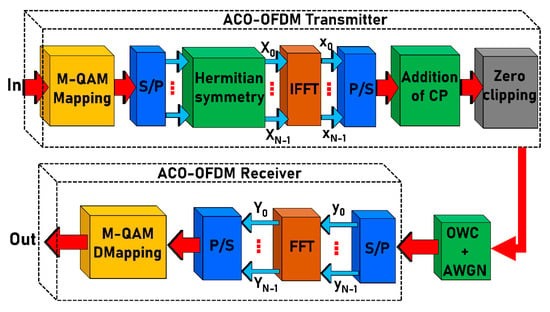
Figure 1.
Asymmetrically clipped optical orthogonal frequency division multiplexing (ACO-OFDM) system.
At the transmitter, the input data bits are converted to complex symbols by M-QAM and then converted to N parallel symbols, where N is the number of the subcarriers of the OOFDM system. After this, Hermitian symmetry is realized for the N parallel symbols, as in Equations (6) and (7). In ACO-OFDM, only the odd subcarriers are used, and the even subcarriers are zeroed in order to get real values of the signals in the output of the N point Inverse fast Fourier transform (N-IFFT) [6]:
After achieving the Hermitian symmetry, we obtain
Due to the use of Hermitian symmetry with only the odd subcarriers, after the IFFT (in the time domain of the signals), we obtain the anti-symmetry property, as obtained in (9), and the imaginary parts of the time domain signals are zero:
After the IFFT, the N parallel time domain signals are converted to one serial stream to be transmitted in time domain. Then, a cyclic prefix (CP) is added to the transmitted signals in order to prevent ISI. The negative values are clipped. This does not lead to any loss of information due to the anti-symmetry property in (9). Then, the transmitted data passes through the FSO atmospheric turbulent channel with additive white Gaussian noise (AWGN) and arrives at the receiver. At the receiver, a photo detector detects the received power of the signal, and a reverse process back to the transmitter is implemented.
The BER performance of ACO-OFDM modulated signals with any M-QAM constellation which propagates through a turbulent channel can be calculated as follows [26,27,28]:
where M is the number of the constellation, is the electrical signal to noise ratio (SNR) per bit, and is the complementary error function. Then, the average BER of the ACO-OFDM transmitted data over the noisy channel can be obtained by averaging (10) over the scintillation distribution:
where is the PDF of the received signal at the receiver, and I is the intensity of the transmitted signal. When the channel is characterized by weak or strong turbulence, the PDF of the received signal is lognormal and Gamma–Gamma distributed, as shown in (3) and (4), respectively. In the two cases, depends on the scintillation index parameter and affects the BER performance of the ACO-OFDM system. When the value of increases, the BER also increases. Therefore, in order to recover the data with a minimum BER resulting from the turbulence, it is very important to estimate accurately the CSI of the turbulent channel in order to help mitigate the turbulence. When the channel is with strong turbulence or the turbulence over the channel is unknown or variable, it is difficult to estimate the CSI accurately and to implement ACO-OFDM over FSO turbulence channels. Therefore, there is a great need to enable the use of this modulation scheme over FSO communication channels without knowing the parameters of the channel. To accomplish this, DL is proposed as a method that can replace the regular ACO-OFDM detectors to overcome the above problems and to enable the use of ACO-OFDM over different FSO turbulence channels, as explained in the next section.
3. Our Proposed DL Detection Models
DL is a neuron system model that maps input to output data through a graph that contains several layers. The input data are data with noise after passing through a specific system. The output of the DL system is the original data that the DL wants to detect. Each layer maps the data through nodes, where the first layer is the input data. Each layer depends on the value of the nodes in the previous layer after passing an activation function. DL tries to optimize the performance of the system through two stages. The first is called the training process, and the second is called the prediction process. At the beginning of the training process, the DL system model sets random values to the weights, which are the connections between the nodes in each of two consecutive neighboring layers, and then it changes the weights of the DL model by a gradient descent method in a number of iterations until it reaches the minimum loss between the output of the DL system and the original output. Then, after the training process, the system saves the final weights with the minimum loss and then starts an online process called the prediction process. In this process, the system receives online data and detects the original data, depending on the weights that were saved in the previous process. In recent years, many researchers have used DL for improving the performance of a system in many fields, including speech recognition, wireless communication, optical wireless communication, etc. In [23], we successfully used DL for improving the performance of OOK modulation over different FSO turbulent channels. The received data are a corrupted version of the data after passing through turbulence, and the output data are the original data bits that we want to detect. Here, we want to use the same concept as in [23], to improve the performance of modulated ACO-OFDM signals. We know that this modulation is similar to OOK but is more sophisticated. In both modulation systems, the DL system receives modulated data after it has passed through a turbulent channel with noise and is required to recover the original data bits. In this section, we propose a new DL detection method for ACO-OFDM for FSO communication to enable its use over different turbulent channels and to improve the performance of the FSO communication system when the channel is characterized by strong turbulence or is variable, without the need to know anything about the parameters of the channel. The system of our model is presented in Figure 2.
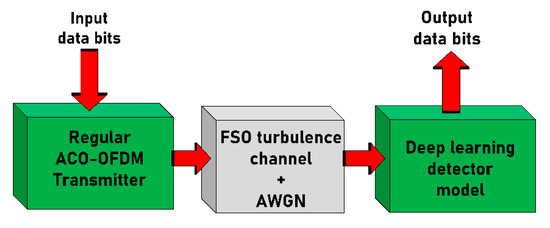
Figure 2.
The proposed system.
In order to use DL systems, we need to learn through a training process, which requires a dataset. For this, we build a dataset by generating random data bits and modulating them by ACO-OFDM modulation, and then, we send them through different atmospheric turbulent channels with AWGN. The receiver recovers the modulated data via a regular ACO-OFDM decoder using an MMSE estimator. For each generated dataset, we create and save two vectors: the input and output vectors. The input vector is the input to the DL system that contains the input data to the ACO-OFDM receiver, which is the modulated data with AWGN after passing through the turbulent channel. The output vector is the original generated data bits. In the training process, the model learns and changes the weights of the DL model until it reaches the minimum loss condition between the output of the DL system and the original output. Then, after the training process, the system saves the final weights with the minimum BER and starts an online process. In the online process, the system can receive any ACO-OFDM modulated data with AWGN after passing through the turbulent channel and detect the original data bits, depending on the weights.
In our work, we used different DL models. In the first model, we used a fully connected (FC) neural network, and in the second model, we used a fully convolutional neural network (FCNN). Schemes of the DL models that we built are presented in Figure 3 and Figure 4.
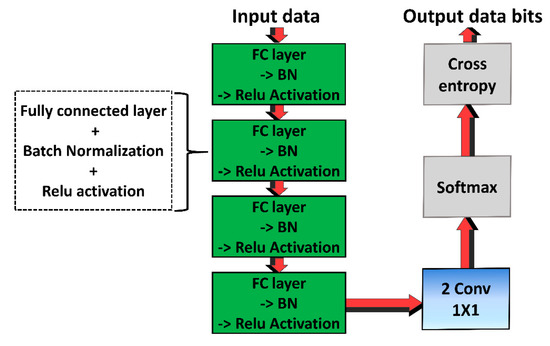
Figure 3.
Our proposed ACO-OFDM decoder 1 using the fully connected (FC) network.
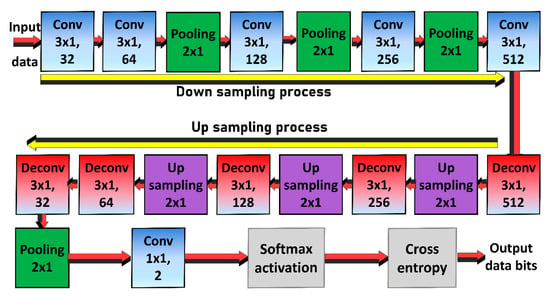
Figure 4.
Our proposed ACO-OFDM decoder 2 using fully convolutional neural network (FCNN) network.
One of the most important things in DL is to properly tune the hyperparameters of the DL network to enable the receiver to recover the original data bits with minimum loss. In general, DL networks should include an input layer, output layer, and several internal layers. We chose the number of nodes in the input layer to be equal to the number of the received data vectors at the receiver that we wanted to demodulate. The number of the nodes in the output layer must be equal to the number of the generated data bits at the transmitter that we wanted to detect. There is no specific way to decide the number of internal layers, so we determined by trial and error until we obtained minimum loss. At the input of our system, we normalized the input data to reduce the variance of the input data scaling. This helped accelerate the training process.
In the first model, we used a FC network with five layers. The first three layers are FC layers with 512 nodes, and the fourth layer is an FC layer with 256 nodes. In the last layer, we used a convolutional layer with two classes with size 1 × 1. Each output node in the last layer detects the recovered bit and decides if it is zero or one, as in Figure 3.
After each one of the internal layers, which are layers 1 to 4, we use a relu activation function as shown in Equation (12). It is proper for DL in optical communication and is widely used by other researchers:
After the last layer, we use a softmax activation function, given by Equation (13), because softmax activation is an easy function widely used to convert the values of the output data to probabilities between 0 and 1.
Then, we use the cross-entropy loss function in (14), which is suitable for detecting a vector of data by minimizing the distance between the original data and the predicted data, where p is the probability of the original data bits and q is the estimated output probability of our DL system which we require to be minimum through the training process.
The output layer of our model determines the value of each and every bit—if that bit is 0 or 1—by calculating cross entropy loss. This yields a minimum distance loss between the output of the DL system and the original data.
In the second model, we use FCNN. The concept is taken from [11], where it is proposed for image segmentation, which means determining whether each pixel in the output image is foreground or background. We used FCNN because the aim of our network is to make a semantic segmentation for each output bit. FCNN includes two processes, a down-sampling process and an up-sampling process. The down-sampling process comprises a number of convolutional and pooling layers used to detect high-resolution information in the image. The up-sampling process is the inverse process of the down-sampling process and comprises a number of de convolutional and up-sampling layers, which are used to extract the precise localization of the extracted data after the down-sampling process. The output layer of the system is a convolution layer that contains two channels: one channel predicts if this pixel is background, and the other predicts if it is foreground. In our FCNN model, we used the concept in [11], but we changed it to be suitable for our problem. Our FCNN model receives input vectors with noise and performs a number of operations on this input vector by two processes, as in the FCNN models: a down-sampling process that comprises a number of convolutional layers with pooling layers in order to interpret the data and then to know the precise localization for the data extracted by the up-sampling process. In the down-sampling process, we used convolutional layers of 32 filters, each of size 3 × 1, and then we used four convolutional layers with filter sizes 64, 128, 256, and 512, each filter of size 3 × 1, between each two layers. We down-sampled the size of the data by pooling. After this process, we used an inverse process of four deconvolutional layers with sizes 512, 256, 128, and 64 filters. Each filter is of size 1 × 3. We up-sampled a 1 × 2 layer between each two deconvolutional layers, as shown in Figure 4. After each internal layer, we used a relu activation layer, as given above in Equation (12), with batch normalization. After these two processes, we used a pooling layer followed by a convolutional layer of two filters, each one of size 1 × 1. We apply softmax activation as in (13) and use a cross-entropy loss process to obtain the minimum loss between the original data and the output of the DL system as in (14). At the outputs of our systems, we get two values of accuracy and loss. The model trains over a number of iterations until we obtain results with maximum accuracy and minimum loss. The BER is calculated as , and is the ratio of number of correct predictions to the total number of input samples. Performances of the DL decoder and the regular ACO-OFDM decoder that used the MMSE estimator are compared. In the next section, we present the results of our proposed DL models and compare them with the results of the ACO-OFDM decoder that uses the MMSE estimator.
4. Simulation Results
In this section, we describe the simulation results of our DL models and compare them with the simulation results of regular ACO-OFDM schemes in terms of performance and energy consumption. Our aim is to replace the regular ACO-OFDM receiver with the DL systems that we built. In order to check our DL models, we needed to generate datasets of input and output data vectors. The input to the DL system is the modulated data received at the input to the receiver. The output of the DL system is the detected data bits. Through the training process, the DL system tries to learn to recover the data in a number of iterations until it succeeds in reaching the minimum distance between the original and the recovered data bits. The dataset of our DL systems includes 10,000 random input–output vectors built by the MATLAB program. We built our DL decoders using Tensorflow software. The output vectors are the output of the DL decoder and are of size 256 data bits of 0 and 1. The input vectors are input ACO-OFDM data bits modulated by 16 subcarriers. We run our simulations on a computer with a CPU Intel Core i7-7500U 2.7 GHz.
We tested our DL models and compared them with the standard ACO-OFDM decoder system for different levels of turbulence in the channels. We passed our modulated ACO-OFDM data through weak and strong turbulence in cases of slow fading with a stationary channel and fast fading with a non-stationary channel. The strength parameters for the different turbulence channels that we used and the hyperparameters of our DL systems are presented in Table 1.

Table 1.
Simulation parameters.
The BER performance results of our DL models compared with the regular ACO-OFDM decoder system when the channel is with fast fading and non-stationary are presented in Figure 5 for strong turbulence.
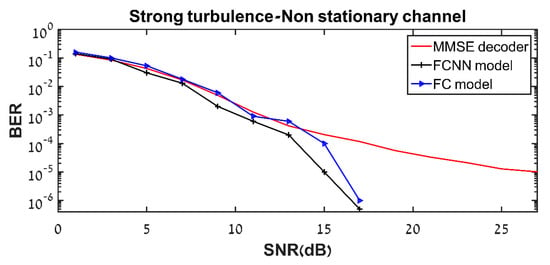
Figure 5.
Bit error rate (BER) performance against normalized SNR for ACO-OFDM with minimum mean square error (MMSE) estimator, our FC model, and the FCNN model for strong turbulence and non-stationary channel.
The red curve is the BER performance of the ACO-OFDM decoder using the MMSE estimator, the black curve is the results of our FCNN model, and the blue curve is the results of our FC DL model. We see that the results of our DL models are very close to each other and very close to results of the regular ACO-OFDM until SNR = 13. After this, our DL models improve the performance of the ACO-OFDM system and lead to a significant decrease in BER compared to the regular ACO-OFDM decoder. For example, after SNR = 14, the BER performance of our models decreases rapidly to values less than 10−6. On the other hand, the BER performance in regular ACO-OFDM for the same SNR is equal to 10−4, and at SNR = 25, it reaches 5.10−4 and does not decrease further, because the channel is non-stationary, and it is difficult for the MMSE estimator to estimate the CSI in order to get optimal performance.
The results of our FCNN DL model when the channel is stationary with slow fading and strong turbulence are presented in Figure 6.
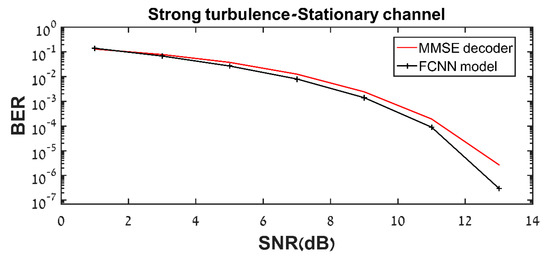
Figure 6.
BER performance against normalized SNR for ACO-OFDM with MMSE estimator and our FCNN model when the channel is stationary with strong turbulence.
The results of our FCNN DL model when the channel is stationary with weak turbulence are shown in Figure 7.
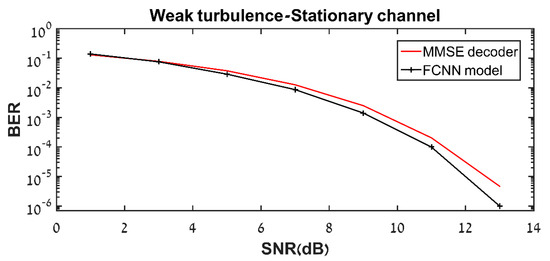
Figure 7.
BER performance against normalized SNR for ACO-OFDM with MMSE estimator and our FCNN model when the channel is stationary with weak turbulence.
In Figure 6 and Figure 7, the red curve represents the BER performance of the regular ACO-OFDM decoder using the MMSE estimator, and the black curve represents the results of our FCNN model. We see that our FCNN DL model yields performance very close to that of the MMSE estimator when the channel is stationary with weak turbulence or with strong turbulence. However, the advantages of our DL models are clearly shown in Figure 8. When the channel is characterized by weak turbulence and is non-stationary with fast fading, the regular ACO-OFDM decoder using the MMSE estimator does not succeed in recovering the corrupted data. Since for the same BER this method requires higher SNR, it consumes much more energy compared to our DL models, which succeed in recovering the data with less energy consumption and manage to decrease BER by more than 8 dB. For example, when the SNR is larger than 25, the regular ACO-OFDM decoder yields a BER performance equal to 10−6 and does not achieve a lower value than this, even at higher SNR. However, in our FCNN DL model, when the SNR is 17 dB, we succeed in getting BER performance equal to 10−7, and with this SNR, we recover the transmitted data without errors. In other words, we get a BER equal to zero.
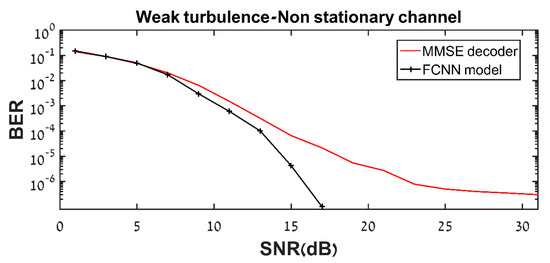
Figure 8.
BER performance against normalized SNR for ACO-OFDM with an MMSE estimator and our FCNN model when the channel is non-stationary with weak turbulence.
In addition to this, another advantage of our DL models is that they are faster than the regular ACO-OFDM decoder. The prediction time of our DL models after the training process is faster than that of the regular ACO-OFDM decoder, as shown in Figure 9.
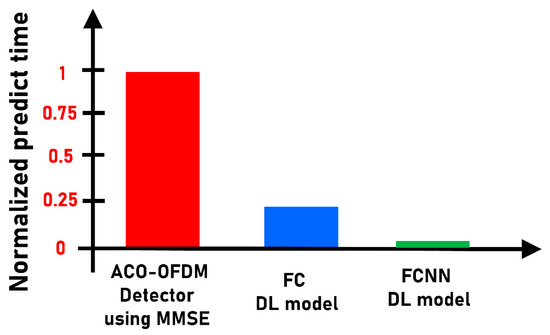
Figure 9.
Normalized prediction times for the different models.
Our FCNN DL model recovers the data more than 10 times faster than the regular decoder. In addition, the prediction time is three times faster than for our FC DL model. This is because the nodes in each layer in the FC model are connected to all the nodes in the next layer. This take time, but the nodes in each layer in the FCNN model are not connected to all the nodes in the next layer. The DL method consumes less time and less energy than the FC model and the regular ACO-OFDM detector. After the training process, we do not need, as in the regular ACO-OFDM decoder, to go through all the blocks of the decoder one by one, which would consume time and energy. After the training process, the weights are saved in the system, and any online received modulated ACO-OFDM can be recovered directly.
Therefore, in this work, our DL models succeed in recovering the received ACO-OFDM data when the channel is with strong and weak turbulence, when the channel is stationary with slow fading, and when the channel is non-stationary with fast fading. Our DL models offer performance very close to that of ACO-OFDM using the MMSE estimator, and it is even slightly better when the channel is stationary. However, when the channel is fast fading and non-deterministic, our DL models can recover the data with better performance than the MMSE estimator. When the channel is variable, this estimator does not manage to reach optimal performance because the channel is not stationary. In addition to these advantages, our models work faster than the regular ACO-OFDM decoder, so they are very efficient for use in real environments where energy saving is important.
5. Conclusions
In this article, we present methods that improve the performance of an ACO-OFDM decoder system by using different DL algorithms. We build two different DL decoders, using fully convolutional neural networks and fully connected neural networks. We compare the performances of the different models that we built with one another, and with the performance of the regular ACO-OFDM decoder using the MMSE estimator system. The use of DL algorithms helps to recover the corrupted modulated transmitted data and succeeds in reducing the BER of the system. Our DL systems improve the performance of the system and decrease the SNR by more than 8 dB when the channel is non-deterministic in both weak and strong turbulent channels. When the channel is stationary, we achieve performance slightly better than that of the ACO-OFDM decoder using the MMSE estimator. Moreover, our decoders are better than the regular decoder in terms of speed and energy consumption. In real environments, we train the system just one time. After the training, the weights are saved, and we only need to predict each input according to the saved weights. The prediction process does not take time and does not consume energy. By using our models, we can implement ACO-OFDM in both stationary and non-stationary channels without needing previous knowledge of the CSI, unlike in the case of regular ACO-OFDM decoders such as MMSE. It is known that high-order Quadrature Amplitude Modulation (QAM) allow many bits per symbol, thus increasing spectral efficiency. Since DL can decrease BER and thus improve reliability, our DL models should also increase spectral efficiency.
Author Contributions
Conceptualization, L.D.; methodology, L.D.; software, L.D.; validation, L.D. and N.K.; formal analysis, L.D. and N.K.; investigation, L.D.; resources, L.D.; data curation, L.D.; writing—original draft preparation, L.D.; writing—review and editing, L.D. and N.K.; visualization, L.D.; supervision, N.K.; All authors have read and agreed to the published version of the manuscript.
Funding
Outstanding doctoral fellowship for the Arab society and minorities in Israel from Council for Higher Education in Israel.
Acknowledgments
We thank Dan Sadot for his very helpful comments and suggestions.
Conflicts of Interest
The authors declare no conflict of interest.
References
- Kaushal, H.; Jain, V.K.; Kar, S. Free Space Optical Communication; Springer: Gurgaon, India, 2017; Volume 18. [Google Scholar]
- Blaunstein, N.; Arnon, S.; Kopeika, N.; Zilberman, A. Applied Aspects of Optical Communication and LIDAR; Auerbach Publications; CRC Press; Taylor & Frances Group: Boca Raton, FL, USA, 2009. [Google Scholar]
- Denise Lund, D.; MacGillivray, C.; Turner, V.; Morales, M. Worldwide and Regional Internet of Things (Iot) 2014–2020 Forecast: A Virtuous Circle of Proven Value and Demand; Technical Report 1; International Data Corporation (IDC): Framingham, MA, USA, 2014. [Google Scholar]
- Yaqoob, I.; Ahmed, E.; Hashem, I.A.T.; Ahmed, A.I.A.; Gani, A.; Imran, M.; Guizani, M. Internet of things architecture: Recent advances, taxonomy, requirements, and open challenges. IEEE Wirel. Commun. 2017, 24, 10–16. [Google Scholar] [CrossRef]
- Dissanayake, S.D.; Panta, K.; Armstrong, J. A novel technique to simultaneously transmit ACO-OFDM and DCO-OFDM in IM/DD systems. In Proceedings of the IEEE GLOBECOM Workshops (GC Wkshps), Houston, TX, USA, 5–9 December 2011; pp. 782–786. [Google Scholar]
- Dissanayake, S.D.; Armstrong, J. Comparison of ACO-OFDM, DCO-OFDM and ADO-OFDM in IM/DD Systems. J. Light. Technol. 2013, 31, 1063–1072. [Google Scholar] [CrossRef]
- Kahn, J.M.; Barry, J.R. Wireless infrared communications. Proc. IEEE 1997, 85, 265–298. [Google Scholar] [CrossRef]
- Armstrong, J.; Lowery, A.J. Power efficient optical OFDM. Electron. Lett. 2006, 42, 370–372. [Google Scholar] [CrossRef]
- Errong, C.P.; Fang, L.J. Optimal power allocation for OFDM-based cognitive radio systems with fair protection against primary users. J. Comput. Inf. Syst. 2012, 8, 9831–9837. [Google Scholar]
- Wu, D.; Wang, Z.; Wang, R.; He, J.; Zuo, Q.; Zhao, H. Channel estimation for asymmetrically clipped optical orthogonal frequency division multiplexing optical wireless communications. IET Commun. 2012, 6, 532–540. [Google Scholar] [CrossRef]
- Zhao, H.; Li, M.; Wang, R.; Wu, D. Channel estimation for asymmetrically clipped optical orthogonal frequency division multiplexing communication system. Opt. Eng. 2013, 52, 076111. [Google Scholar] [CrossRef]
- Qaisar, S.; Bilal, R.M.; Iqbal, W.; Naureen, M.; Lee, S. Compressive sensing: From theory to applications, a survey. J. Commun. Netw. 2013, 15, 443–456. [Google Scholar] [CrossRef]
- Chen, L.; Krongold, B.; Evans, J. Performance analysis for optical OFDM transmission in short-range IM/DD systems. J. Light. Technol. 2012, 30, 974–983. [Google Scholar] [CrossRef]
- Bengio, Y.; Goodfellow, I.; Courville, A. Deep Learning; MIT Press: Cambridge, MA, USA, 2017; Volume 1. [Google Scholar]
- Fehske, A.; Gaeddert, J.; Reed, J.H. A new approach to signal classification using spectral correlation and neural networks. In Proceedings of the First IEEE International Symposium on New Frontiers in Dynamic Spectrum Access Networks, DySPAN, Baltimore, MD, USA, 8–11 November 2005; pp. 144–150. [Google Scholar]
- Azzouz, E.E.; Nandi, A.K. Modulation recognition using artificial neural networks. In Automatic Modulation Recognition of Communication Signals; Springer: Boston, MA, USA, 1996; pp. 132–176. [Google Scholar]
- Ibukahla, M.; Sombria, J.; Castanie, F.; Bershad, N.J. Neural networks for modeling nonlinear memoryless communication channels. IEEE Trans. Commun. 1997, 45, 768–771. [Google Scholar] [CrossRef]
- Sjöberg, J.; Zhang, Q.; Ljung, L.; Benveniste, A.; Delyon, B.; Glorennec, P.Y.; Hjalmarsson, H.; Juditsky, A. Nonlinear black-box modeling in system identification: A unified overview. Automatica 1995, 31, 1691–1724. [Google Scholar] [CrossRef]
- Nelson, D.; Wang, J. Introduction to artificial neural systems. Neurocomputing 2003, 4, 328–330. [Google Scholar] [CrossRef]
- Li, J.; Zhang, M.; Wang, D.; Wu, S.; Zhan, Y.Z.Y. Joint atmospheric turbulence detection and adaptive demodulation technique using the CNN for the OAM-FSO communication. Opt. Express 2018, 26, 10494–10508. [Google Scholar] [CrossRef] [PubMed]
- Khan, F.N.; Zhong, K.; Zhou, X.; Al-Arashi, W.H.; Yu, C.; Lu, C.; Lau, A.P.T. Joint OSNR monitoring and modulation format identification in digital coherent receivers using deep neural networks. Opt. Express 2017, 25, 17767–17776. [Google Scholar] [CrossRef] [PubMed]
- Amirabadi, M.A. A deep learning based solution for imperfect CSI problem in correlated FSO communication channel. arXiv 2019, arXiv:1909.11002. [Google Scholar]
- Darwesh, L.; Kopeika, N.S. Deep learning for improving performance of OOK modulation over FSO turbulent channels. IEEE Access 2020, 8, 155275–155284. [Google Scholar] [CrossRef]
- Andrews, L.C.; Phillips, R.L. Laser Beam Propagation through Random Media; SPIE Press: Bellingham, WA, USA, 2005. [Google Scholar]
- Navidpour, S.M.; Uysal, M.; Kavehrad, M. BER performance of free-space optical transmission with spatial diversity. IEEE Trans. Wirel. Commun. 2007, 6, 2813–2819. [Google Scholar] [CrossRef]
- Cho, K.; Yoon, D. On the general BER expression of one- and two-dimensional amplitude modulations. IEEE Trans. Commun. 2002, 50, 1074–1080. [Google Scholar] [CrossRef]
- Mesleh, R.; Elgala, H.; Haas, H. On the performance of different OFDM based optical wireless communication systems. J. Opt. Commun. Netw. 2011, 3, 620–628. [Google Scholar] [CrossRef]
- Darwesh, L.; Shlomi, A. Energy reduction using multi-channels optical wireless communication based OFDM. In Advanced Free-Space Optical Communication Techniques and Applications III; Proc. SPIE: Warsaw, Poland, 2017; Volume 10437. [Google Scholar]
Publisher’s Note: MDPI stays neutral with regard to jurisdictional claims in published maps and institutional affiliations. |
© 2020 by the authors. Licensee MDPI, Basel, Switzerland. This article is an open access article distributed under the terms and conditions of the Creative Commons Attribution (CC BY) license (http://creativecommons.org/licenses/by/4.0/).